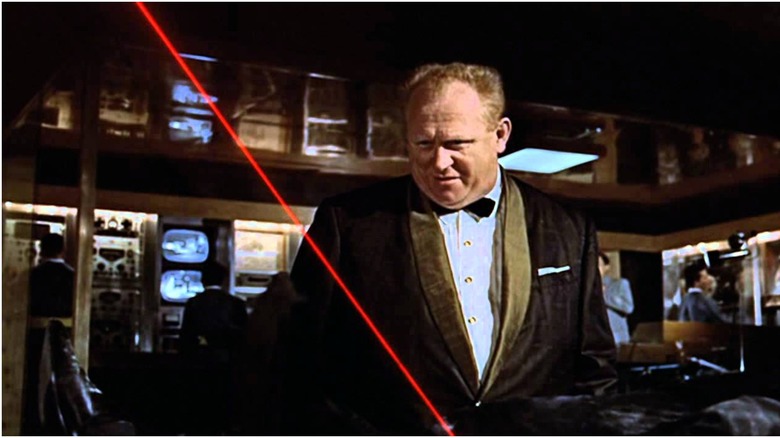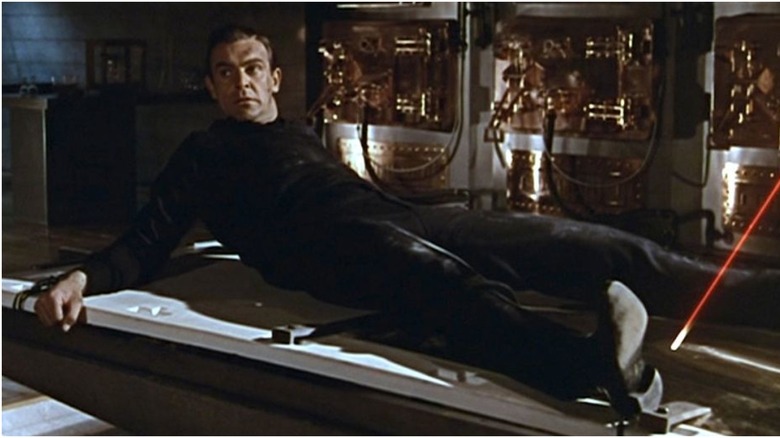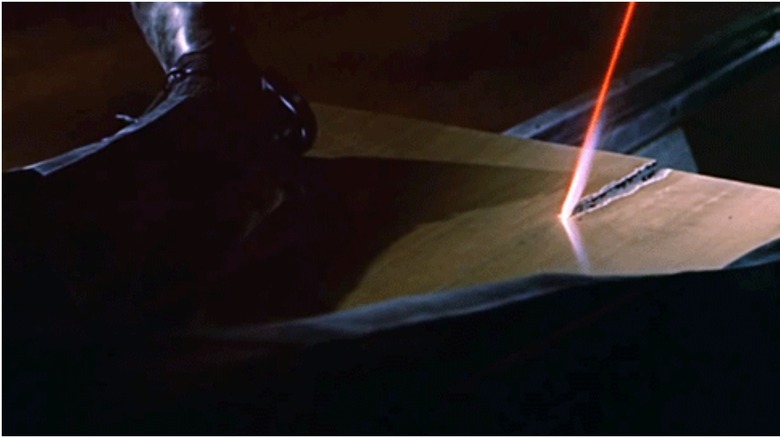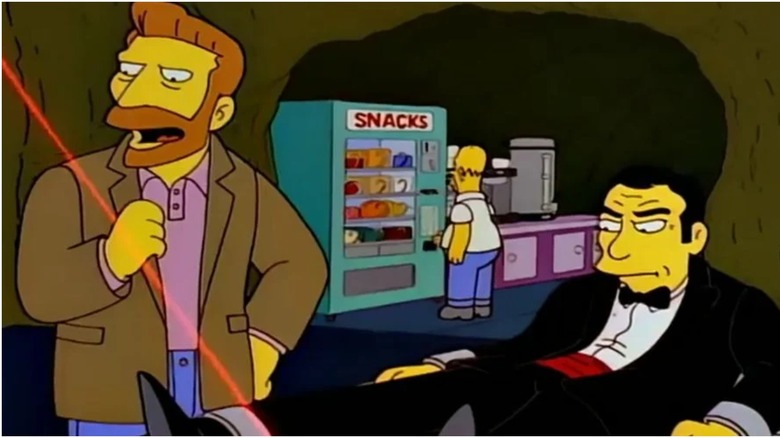How The Goldfinger Crew Pulled Off That Famous Laser Beam Scene
"Goldfinger," the third James Bond film, is where most of the series' most famous clichés originate. Previous films "Dr. No" and "From Russia With Love" were more straightforward spy thrillers, whereas "Goldfinger" throws any realism to the wind; Bond squares off not with SPECTRE agents, but a bonafide super-villain. Said super-villain, Auric Goldfinger (Gert Fröbe, dubbed by Michael Collins), is the first Bond villain to place 007 in an over-the-top deathtrap. And if you haven't seen the film or any of its countless parodies, said deathtrap is an industrial laser. Goldfinger straps a captured Bond to a gold table spread eagle and sets the laser to vertically bisect 007.
It's one of the most famous scenes in movie history. But how was it brought to life?
Why a laser?
In the film's source material, Ian Fleming's 1959 novel of the same name, the trap which threatens to bifurcate Bond is a circular saw. Screenwriter Richard Maibaum is the one who changed the saw to a laser. "We were sure audiences would find the episode old-fashioned, hackneyed and ridiculous," Maibaum said in "License to Thrill: A Cultural History of the James Bond Films" by James Chapman. Considering how iconic the laser has become, Maibaum made the right call.
Why a laser, specifically? Because in 1964, a laser was cutting edge (pun intended) technology. Lasers — or Light Amplification by Stimulated Emission of Radiation — were invented in 1960; when "Goldfinger" was filmed, scientists still hadn't figured out a practical use for them. Giving Goldfinger a laser for his deathtrap gave the scene a science-fiction flavor and made it more exciting for audiences. The laser's inclusion also wound up giving birth to a whole new Bond cliché.
To ensure that audiences would understand the laser, Maibaum and his co-writer Paul Dehn wrote Goldfinger some dialogue explaining the machine and how it works before activating it: "You are looking at an industrial laser, which admits an extraordinary light not to be found in nature. It can project a spot on the moon, or at closer range, cut through solid metal. I will show you." However, later Bond films stuck with this sort of pre-deathtrap exposition even though there was no real need; the villain captures Bond, puts the hero in an overelaborate deathtrap, and gloats about the machine's mechanics.
Something's under the table
The laser scene was the first to be filmed for "Goldfinger" and one of the trickiest to complete. For starters, the laser itself was a dangerous tool not conducive for filming. Special effects supervisor Cliff Culley said, "They bought a real laser in, which looked great. It had a pencil-thin line, but as soon as you turned all the studio lights on, it disappeared."
In his book, "Gimmick Man: Memoir of a Special Effects Maestro," effects technician Albert Luxford added:
"[The laser] was an extremely dangerous thing insofar as it having 400 to 500 volts going through the coil ... If you touched it, you'd have been dead. It wasn't a toy. If you'd gone within a foot of it when it was on, you'd have had arcs too — giving a very nasty shock, to say the least."
For these reasons, the real blue beam fired from the machine was not used; the orange laser beam in the film was added as an optical effect in post-production.
Unable to use the real laser to cut through the table, the crew improvised. During shooting, Luxford sat under the table and cut from underneath it with a blowtorch. In the scene, Bond mentioning Goldfinger's "Operation: Grand Slam" is what gets him out of a clean-cut death; Sean Connery saying these words was Luxford's cue to stop cutting. Luxford recalled in "Gimmick Man":
"As I got nearer and nearer to his crotch, Sean was sweating a bit... I was about three inches from his crotch when I stopped."
Parodies after parody
The laser scene is one of the most iconic in 007 history. As deathtraps come and go, Goldfinger's laser remains in the public memory. Its legacy endures outside the Bond franchise into the realm of parody; "The Simpsons" episode "You Only Move Twice" includes a direct reference to the scene.
The Simpsons move to the town of Cypress Creek when Homer gets a job offer from secret super-villain Hank Scorpio. One "Mr. Bont" attempts to foil Scorpio, but is trapped in the same predicament Goldfinger put Bond in. Scorpio and Bont exchange a variation of the most famous dialogue in "Goldfinger" ("You expect me to talk?" "No, Mr. Bond, I expect you to die!") before Bont escapes from the trap. Unfortunately, Bont didn't count on Homer being there to trip him up.
There's also "Austin Powers," a comedy franchise built on parodying Bond; it would've been incomplete without a "Goldfinger" send-up. Dr. Evil's obsession with creating shark with laser beams attached to their heads merges the "Goldfinger" laser scene and a repeated type of deathtrap in Bond films: shark pools, as seen in "Thunderball," "Live and Let Die," "The Spy Who Loved Me," and "Licence to Kill." The third film, "Goldmember," is, of course, named after "Goldfinger" and features a more explicit parody. Powers' father Nigel (Michael Caine) is strapped to a device that moves him crotch first towards molten gold. Like Bond, Nigel only narrowly avoids emasculation.
Watching these parodies can make it hard to appreciate the original moment, but the scene holds up on its own merits. The laser effects are still impressive and the rapid cutting makes the stakes all the more nail-biting. Most importantly, Connery's genuine nervousness serves the scene so very well — it's the only time that his iteration of 007 seems afraid.



